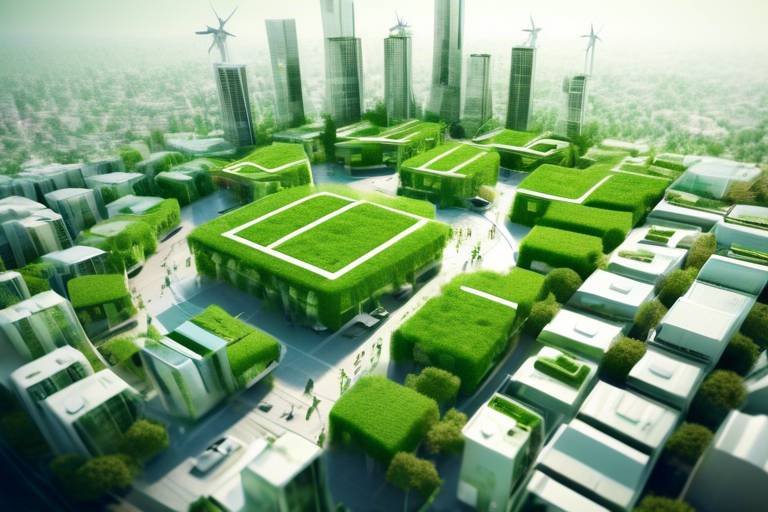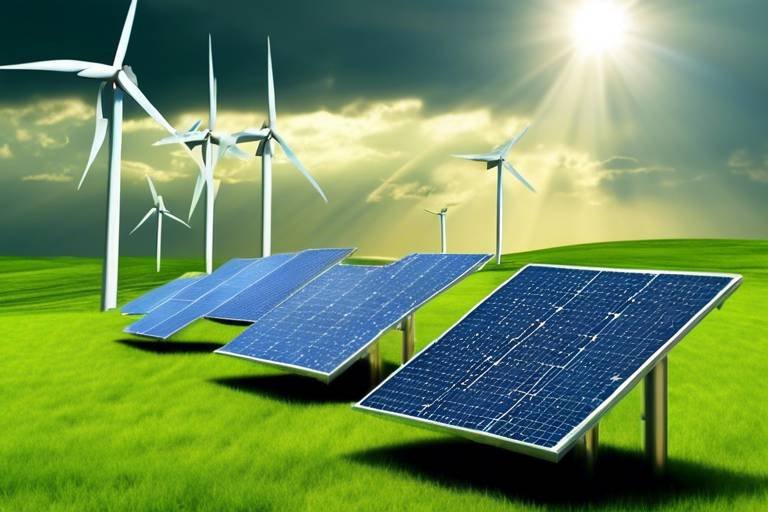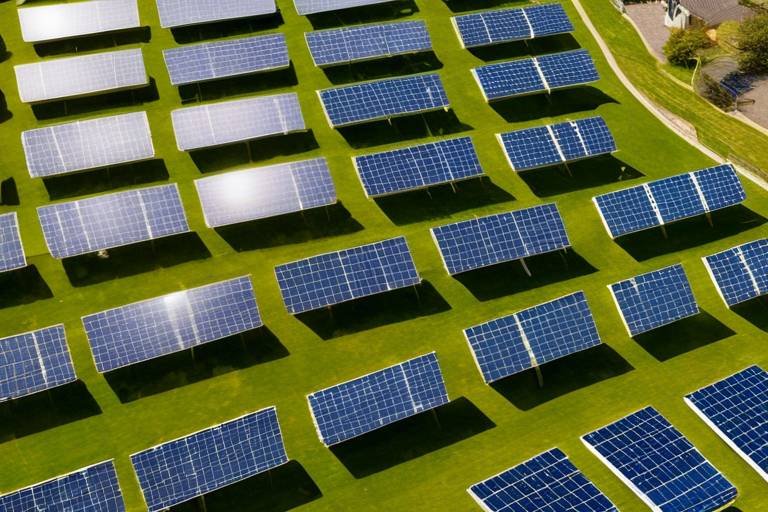The Integration of Green Energy Solutions into Smart Cities
As urbanization accelerates, cities around the globe face a myriad of challenges, from overcrowding to pollution and climate change. In response, the concept of smart cities has emerged, representing a revolutionary approach to urban living. Smart cities leverage cutting-edge technology and data analytics to enhance sustainability, improve efficiency, and elevate the quality of life for residents. But what truly sets these cities apart is their integration of green energy solutions. By harnessing renewable energy sources, smart cities are not only addressing the pressing issue of climate change but also paving the way for a more resilient urban future.
Imagine walking through a city where the air is clean, the streets are lined with trees, and energy is generated from the sun and wind that surrounds you. This is the vision that smart cities aim to achieve through the incorporation of green energy technologies. By prioritizing renewable energy, urban planners are creating environments that are not only livable but also sustainable for generations to come. The integration of these solutions is a multi-faceted endeavor that involves innovative technologies, community engagement, and supportive policies.
In this article, we will delve into how green energy solutions are reshaping urban landscapes, from solar innovations that harness sunlight to wind turbines that capture breezes. We will explore the significance of energy storage technologies in managing the intermittent nature of renewable sources and the vital role of government policies in promoting sustainable practices. By the end of our journey, you'll see how the fusion of green energy and smart city concepts is not just a trend but a necessary evolution for urban living.
Smart cities are defined by their ability to utilize technology and data to enhance urban living. They employ a combination of Internet of Things (IoT) devices, data analytics, and citizen engagement to create a more responsive and efficient urban environment. Key characteristics of smart cities include:
- Data-Driven Decision Making: Utilizing real-time data to inform city management and infrastructure development.
- Connected Infrastructure: Integrating various urban systems, such as transportation and energy, to improve overall efficiency.
- Citizen Engagement: Involving residents in decision-making processes through digital platforms and community initiatives.
These elements work together to create a dynamic urban ecosystem where technology and sustainability go hand in hand. For instance, smart traffic systems can reduce congestion and pollution, while smart waste management can optimize collection routes and reduce landfill waste. The foundation of a smart city is built on the principles of innovation, sustainability, and inclusivity, ensuring that all residents benefit from advancements in technology.
At the heart of smart cities lies the imperative to reduce carbon footprints and combat climate change. Green energy sources, such as solar, wind, and hydroelectric power, play a crucial role in this endeavor. These renewable energy options not only provide cleaner alternatives to fossil fuels but also enhance energy security for urban areas. By investing in green energy, cities can significantly lower their greenhouse gas emissions and create a more sustainable future.
Solar energy technologies have seen remarkable advancements in recent years. With the introduction of photovoltaic (PV) panels and solar thermal systems, urban areas are transforming their energy landscapes. These innovations allow cities to harness sunlight effectively, generating clean energy for homes and businesses. For example, many smart cities are now incorporating solar panels on rooftops, which not only provide electricity but also reduce the urban heat island effect.
One exciting development in solar energy is the rise of community solar projects. These initiatives enable neighborhoods to collectively invest in solar energy resources, allowing residents who may not have suitable roofs to benefit from renewable energy. This collaborative approach fosters a sense of community while increasing access to clean energy, illustrating how smart cities can empower their residents.
Furthermore, the integration of solar energy technologies with smart grids enhances the efficiency of energy distribution. Smart grids utilize advanced communication technologies to monitor and manage energy flows, ensuring that renewable energy is used optimally. This synergy not only maximizes the use of solar power but also facilitates the transition to a more sustainable energy system in urban areas.
Wind energy is another vital component of green energy in smart cities. The deployment of urban wind turbines is gaining traction, providing a localized source of renewable energy. These turbines can be installed on rooftops or in public spaces, generating electricity while minimizing the visual impact on the urban landscape. The integration of wind energy contributes to local energy generation, reducing dependency on external sources and enhancing energy resilience.
As renewable energy sources are often intermittent, energy storage technologies are essential for managing supply and demand. Recent developments in battery storage systems have improved their efficiency and capacity, making them a critical component of smart city infrastructure. These advancements ensure that excess energy generated during peak production times can be stored and utilized when demand is high, creating a more stable energy system.
Innovations in battery technology, such as lithium-ion and solid-state batteries, have revolutionized the way we store energy. These advancements not only increase the lifespan and efficiency of energy storage systems but also reduce costs, making renewable energy more accessible for urban areas. As cities invest in these technologies, they are better equipped to integrate renewable sources into their energy mix.
Moreover, energy storage systems enhance urban resilience against power outages and fluctuations in energy supply. By providing backup power during emergencies, these solutions contribute to the overall stability of smart cities. A well-integrated energy storage system can act as a safety net, ensuring that essential services remain operational even during disruptions.
To facilitate the successful integration of green energy solutions, effective policies and regulations are vital. Governments play a crucial role in promoting sustainable practices within smart cities. By establishing clear guidelines and frameworks, they can encourage the adoption of renewable energy technologies and foster innovation.
Government incentives, such as tax credits and grants, are pivotal in encouraging the adoption of renewable energy. These financial incentives make it easier for cities to invest in green technologies, ultimately leading to a more sustainable urban environment. By reducing the financial barriers to entry, cities can accelerate their transition to renewable energy sources.
Lastly, collaborative governance models that involve partnerships between public and private sectors are essential for fostering innovation. By working together, stakeholders can share resources, knowledge, and expertise, driving the integration of green energy solutions in urban settings. This collaborative approach not only enhances the effectiveness of initiatives but also ensures that diverse perspectives are considered in decision-making processes.
Q: What are smart cities?
A: Smart cities utilize technology and data to enhance urban living, focusing on sustainability, efficiency, and improved quality of life.
Q: How do green energy solutions benefit smart cities?
A: They reduce carbon footprints, enhance energy security, and contribute to a more sustainable urban environment.
Q: What role does community solar play in smart cities?
A: Community solar initiatives allow neighborhoods to share renewable energy resources, increasing access to clean energy for residents.
Q: Why are energy storage solutions important?
A: They manage the intermittent nature of renewable energy, ensuring a stable energy supply and enhancing urban resilience.
Q: How do policies influence the integration of green energy?
A: Effective policies and government incentives encourage the adoption of renewable energy technologies and support sustainable practices.

Understanding Smart Cities
Smart cities are a revolutionary concept that harnesses the power of technology and data to enhance urban living. Imagine a bustling metropolis where traffic flows smoothly, energy consumption is optimized, and public services are seamlessly integrated. Sounds like a dream, right? Well, this is the reality that smart cities are striving to create. They are not just about fancy gadgets and apps; they represent a holistic approach to urban planning that prioritizes sustainability, efficiency, and the quality of life for residents.
At the heart of smart cities lies the use of innovative technologies that collect and analyze data to improve city operations. This can include everything from smart traffic lights that adapt to real-time conditions, to sensors that monitor air quality and energy usage. The key characteristics that define a smart city include:
- Connectivity: Smart cities utilize the Internet of Things (IoT) to connect various devices and systems, enabling real-time communication and data sharing.
- Efficiency: By leveraging data analytics, cities can optimize resource allocation, reduce waste, and improve service delivery.
- Sustainability: Smart cities focus on green solutions that minimize environmental impact, such as renewable energy sources and sustainable transportation systems.
- Citizen Engagement: These cities encourage active participation from residents, allowing them to contribute to decision-making processes and urban development.
To illustrate the potential of smart cities, consider the integration of smart public transportation systems. Imagine a scenario where buses and trains are equipped with sensors that provide real-time updates on arrival times and crowd levels. This not only enhances the commuting experience but also encourages more people to use public transport, reducing traffic congestion and lowering carbon emissions.
Moreover, smart cities are characterized by their focus on data-driven governance. City officials can make informed decisions based on comprehensive data analysis, leading to more effective policies and programs. For instance, by analyzing traffic patterns, cities can identify areas prone to congestion and implement targeted solutions, such as dedicated bus lanes or improved cycling infrastructure.
In conclusion, understanding smart cities requires recognizing their multifaceted nature and the role of technology in shaping urban environments. As we continue to face challenges like population growth, climate change, and resource scarcity, the adoption of smart city principles becomes increasingly vital. These cities are not just a trend; they are a necessary evolution in how we think about urban living. The integration of technology, sustainability, and community engagement is paving the way for a brighter, more efficient future for urban residents.

The Role of Green Energy
Green energy is not just a buzzword; it’s a vital component in our fight against climate change and a key player in the development of smart cities. As urban areas continue to grow, the demand for sustainable solutions becomes more pressing. Green energy solutions, such as solar, wind, and hydro power, are essential in reducing carbon footprints and enhancing the quality of life for city dwellers. Imagine a city where clean energy powers your home, your public transport, and even your electric vehicles—this is not a distant dream but a reality that is unfolding right now.
Incorporating green energy into urban environments does more than just cut emissions; it also fosters a sense of community and encourages innovation. For instance, cities that invest in renewable energy sources often see a boost in local economies. When communities harness their own energy, they become less reliant on external sources, which can lead to significant cost savings. Moreover, the importance of green energy extends beyond environmental benefits; it plays a crucial role in improving public health by reducing air pollution and contributing to cleaner air.
To better understand the impact of green energy in smart cities, let’s take a closer look at some of the most significant renewable energy sources:
| Type of Energy | Benefits | Challenges |
|---|---|---|
| Solar Energy | Reduces electricity costs; scalable from residential to large installations | Weather-dependent; initial installation costs can be high |
| Wind Energy | Low operational costs; generates energy even at low wind speeds | Requires significant space; potential impact on wildlife |
| Hydro Energy | Reliable and consistent energy source; can provide flood control | Environmental impact on aquatic ecosystems; limited to certain locations |
Each of these energy sources contributes uniquely to the overall strategy of creating sustainable urban environments. Solar energy, for example, is increasingly being adopted in residential areas through rooftop installations and community solar projects. Wind energy, on the other hand, is making strides with urban wind turbines that harness breezes even in densely populated areas. Hydro energy, while traditionally associated with large dams, is also being explored in smaller, more localized systems that can reduce environmental impact while providing clean energy.
As cities evolve, the integration of these green energy solutions becomes paramount. Not only do they address the pressing issue of climate change, but they also enhance urban resilience by diversifying energy sources. This diversification means that cities are less vulnerable to energy shortages and fluctuations, which can disrupt daily life and economic stability. In essence, green energy is not just about being eco-friendly; it’s about building a robust, sustainable future for urban residents.
In conclusion, the role of green energy in smart cities cannot be overstated. It is a multi-faceted approach that not only aims to diminish our carbon footprint but also enhances community engagement, economic development, and public health. As we continue to innovate and implement these solutions, we pave the way for a brighter, cleaner, and more sustainable urban future.
- What is green energy? Green energy refers to energy derived from renewable, naturally replenished sources such as solar, wind, and hydro power.
- How does green energy benefit smart cities? It reduces carbon emissions, lowers energy costs, enhances public health, and fosters economic growth.
- Can green energy sources be integrated into existing infrastructure? Yes, many green energy solutions can be retrofitted into existing systems, making them adaptable to urban environments.
- What are the challenges of adopting green energy? Challenges include initial costs, space requirements, and potential environmental impacts, but these can often be mitigated through technology and planning.

Solar Energy Innovations
In the ever-evolving landscape of urban energy solutions, are at the forefront, reshaping how cities harness the sun's power. With the world increasingly recognizing the importance of sustainable practices, cities are turning to advanced solar technologies that not only reduce dependency on fossil fuels but also enhance urban aesthetics and functionality. Imagine a city where rooftops glisten with sleek photovoltaic panels, capturing sunlight to power homes, businesses, and even public transportation systems. This is not a distant dream; it's becoming a reality in smart cities around the globe.
One of the most exciting advancements in solar technology is the development of integrated solar panels, which can be seamlessly incorporated into building materials. These panels, often referred to as BIPV (Building-Integrated Photovoltaics), serve a dual purpose: they provide energy while also acting as a roof or façade. This innovation not only maximizes space but also minimizes the visual impact of traditional solar installations. Think of it as wearing a stylish outfit that also has the power to charge your devices—it's functional and appealing!
Moreover, the efficiency of solar panels has skyrocketed in recent years. Traditional panels typically convert about 15-20% of sunlight into electricity, but new technologies are pushing this figure closer to 25% or even higher. For instance, perovskite solar cells are emerging as game-changers in the industry. These cells are cheaper to produce and can achieve higher efficiencies compared to conventional silicon-based panels. As cities adopt these cutting-edge technologies, we can expect a significant boost in renewable energy generation.
Another remarkable innovation is the rise of solar thermal systems, which utilize sunlight to generate heat, rather than electricity. These systems can efficiently provide hot water for residential and commercial use, significantly reducing energy costs. For instance, in smart cities, solar thermal energy can be harnessed to heat swimming pools, provide hot water for showers, and even support district heating systems. The potential for integrating these systems into urban infrastructures is vast, making them an essential component of a sustainable city.
To highlight the impact of solar energy innovations in smart cities, consider the following table that outlines the benefits and applications of various solar technologies:
| Solar Technology | Benefits | Applications |
|---|---|---|
| Photovoltaic Panels | High efficiency, renewable energy source | Residential, commercial, and public buildings |
| Building-Integrated PV | Space-saving, aesthetic appeal | Roofs, facades, and windows |
| Solar Thermal Systems | Cost-effective hot water generation | Heating pools, showers, and district heating |
As we look to the future, the integration of solar energy innovations into smart cities is not just a trend; it's a necessity. With urban populations growing and the challenges of climate change becoming more pressing, cities must embrace these technologies to create a more sustainable and resilient urban environment. The fusion of technology and renewable energy is paving the way for a brighter, cleaner future.
In conclusion, the advancements in solar energy technologies are not only making renewable energy more accessible but also enhancing the quality of life for urban residents. By harnessing the power of the sun, smart cities are setting a precedent for sustainable living, proving that innovation and environmental stewardship can go hand in hand.
Q: What are the main types of solar energy technologies used in smart cities?
A: The main types include photovoltaic panels, building-integrated photovoltaics (BIPV), and solar thermal systems. Each offers unique benefits and applications within urban settings.
Q: How do solar innovations contribute to reducing carbon footprints?
A: By utilizing renewable energy from the sun, these technologies decrease reliance on fossil fuels, thus reducing greenhouse gas emissions and promoting cleaner air quality.
Q: Can solar energy systems be integrated into existing buildings?
A: Yes! Many solar technologies, especially BIPV, are designed to be integrated into existing structures without requiring additional space, making them ideal for urban environments.

Community Solar Initiatives
Community solar initiatives are revolutionizing the way neighborhoods access clean energy. Imagine living in a community where the sun's rays not only brighten your day but also power your home! These projects allow residents to share solar energy resources, making renewable energy accessible to those who may not have the means to install solar panels on their own rooftops. This collaborative approach fosters a sense of community and encourages collective action towards sustainability.
In essence, community solar programs create a shared solar farm where multiple households can invest in a portion of a larger solar installation. This means that even if you live in an apartment or a house with limited roof space, you can still benefit from solar energy. Participants typically receive credits on their electricity bills based on the amount of energy produced by their share of the solar farm. This not only reduces their energy costs but also contributes to a greener planet.
Moreover, community solar initiatives help to democratize energy access. They are particularly beneficial for low-income households or those who rent, as these groups often face barriers to adopting solar technology. By pooling resources, communities can invest in larger solar projects that provide cleaner energy at a lower cost. This model not only enhances the local economy but also empowers residents to take control of their energy sources.
To illustrate the impact of these initiatives, consider the following table that showcases some successful community solar projects across the United States:
| Project Name | Location | Capacity (MW) | Year Established |
|---|---|---|---|
| Solarize Portland | Portland, OR | 1.5 | 2016 |
| Community Solar Garden | Minneapolis, MN | 2.0 | 2015 |
| SunShare Community Solar | Denver, CO | 3.0 | 2014 |
These projects not only generate clean energy but also serve as a catalyst for community engagement. They encourage residents to learn about renewable energy technologies and advocate for more sustainable practices within their neighborhoods. By participating in community solar initiatives, individuals become part of a larger movement towards energy independence and environmental stewardship.
In conclusion, community solar initiatives are a powerful tool for enhancing access to renewable energy, promoting social equity, and fostering community collaboration. As more neighborhoods embrace this model, we can expect to see a significant shift in how urban areas approach energy consumption and sustainability. With these initiatives, the future of urban living looks not only brighter but also greener!

Integration with Smart Grids
As we plunge deeper into the era of smart cities, the integration of renewable energy sources, particularly solar energy, with smart grids has emerged as a game-changer. Imagine a city where energy flows like water, efficiently and seamlessly, adapting to the needs of its inhabitants while minimizing waste. This is the promise of smart grids, which utilize advanced technology to monitor and manage energy distribution effectively. By integrating solar energy solutions, cities can not only reduce their carbon footprints but also enhance their energy resilience.
Smart grids are equipped with real-time data analytics, allowing for dynamic adjustments in energy supply and demand. For instance, when solar energy production peaks during sunny afternoons, the smart grid can redirect excess energy to where it's needed most, whether that’s charging electric vehicles or powering homes. This capability is crucial in urban settings, where energy demands fluctuate significantly throughout the day. The synergy between solar energy and smart grids ensures that cities can harness renewable resources efficiently, minimizing reliance on fossil fuels.
Moreover, the integration of solar energy with smart grids fosters a more decentralized energy model. In traditional energy systems, power generation is often centralized, leading to inefficiencies and vulnerabilities. However, with smart grids, cities can encourage local energy production through community solar initiatives, where neighborhoods can generate and share solar energy. This not only empowers residents but also strengthens community ties as they collaborate to create a sustainable energy future.
To illustrate the impact of smart grid integration, consider the following table that outlines the benefits of combining solar energy with smart grids:
| Benefits | Description |
|---|---|
| Enhanced Efficiency | Smart grids optimize energy distribution, reducing transmission losses and improving overall system efficiency. |
| Increased Resilience | By diversifying energy sources and enabling localized production, cities become more resilient to outages and fluctuations. |
| Cost Savings | Efficient energy management leads to lower operational costs for utilities and savings for consumers. |
| Environmental Impact | Maximizing solar energy usage reduces greenhouse gas emissions and promotes sustainability. |
In conclusion, the integration of solar energy with smart grids is not just a technological advancement; it's a transformative approach to urban energy management. As cities continue to evolve, this integration will play a pivotal role in shaping a sustainable future, offering a cleaner, more efficient, and resilient energy landscape for all urban residents.
- What is a smart grid? A smart grid is an advanced electrical grid that uses digital technology to monitor and manage the transport of electricity from all generation sources to meet the varying electricity demands of end users.
- How does solar energy integrate with smart grids? Solar energy integrates with smart grids by allowing real-time data analytics to optimize energy distribution, enabling local energy production, and enhancing overall efficiency.
- What are the benefits of using smart grids in cities? Benefits include enhanced efficiency, increased resilience against outages, cost savings for utilities and consumers, and a positive environmental impact through reduced emissions.
- Can community solar projects be part of a smart grid? Yes, community solar projects can be integrated into smart grids, allowing neighborhoods to share renewable energy resources and promote local energy production.

Wind Energy Applications
Wind energy is rapidly becoming a cornerstone in the quest for sustainable urban environments, and its applications within smart cities are nothing short of revolutionary. Imagine harnessing the power of the wind—an abundant and renewable resource—to generate clean energy right in the heart of urban landscapes. This isn't just a dream; it's a reality that's taking shape across the globe. As cities evolve to become smarter, integrating wind energy solutions is essential for reducing dependence on fossil fuels and achieving carbon neutrality.
One of the most exciting developments in wind energy applications is the rise of urban wind turbines. Unlike their larger counterparts found in rural areas, these smaller turbines are designed specifically for urban settings. They can be installed on rooftops, integrated into building designs, or even placed in parks. This innovative approach not only maximizes space but also minimizes the visual impact on the cityscape. The compact design of urban wind turbines allows them to operate efficiently in turbulent wind conditions typical of city environments, making them a practical option for generating electricity.
Additionally, the integration of wind energy into smart cities is enhanced by the use of advanced technology. Smart sensors and IoT (Internet of Things) devices can monitor wind speed and direction, allowing for real-time adjustments to energy production. This level of responsiveness ensures that wind energy is utilized effectively, contributing to the overall energy mix of the city. When combined with other renewable sources like solar energy, the reliability and sustainability of urban energy systems significantly improve.
Moreover, community engagement plays a vital role in the adoption of wind energy solutions. Residents can participate in wind energy projects through community wind farms, where multiple households or businesses come together to invest in shared wind turbines. This collaborative approach not only democratizes energy production but also fosters a sense of ownership among community members. By pooling resources, communities can benefit from economies of scale, making wind energy more accessible and affordable.
To illustrate the impact of wind energy applications in smart cities, consider the following table that highlights key benefits:
| Benefit | Description |
|---|---|
| Reduced Carbon Emissions | Wind energy significantly lowers greenhouse gas emissions compared to fossil fuels. |
| Energy Independence | Utilizing local wind resources decreases reliance on imported energy. |
| Job Creation | The wind energy sector generates jobs in manufacturing, installation, and maintenance. |
| Cost-Effectiveness | Wind energy costs have decreased dramatically, making it one of the cheapest forms of energy. |
In conclusion, the integration of wind energy applications into smart cities represents a significant leap towards a sustainable future. By embracing this clean energy source, urban areas can not only enhance their energy resilience but also improve the quality of life for their residents. As we move forward, the collaboration between technology, community involvement, and innovative policies will be crucial in maximizing the potential of wind energy in urban settings.
- What are urban wind turbines? Urban wind turbines are smaller, more efficient wind turbines designed for installation in city environments, often on rooftops or integrated into buildings.
- How does wind energy contribute to smart cities? Wind energy provides a renewable source of electricity, reducing reliance on fossil fuels and lowering carbon emissions, which is essential for sustainability in urban areas.
- Can communities invest in wind energy projects? Yes! Community wind farms allow residents to collectively invest in wind energy, making it more accessible and fostering community ownership.
- What are the economic benefits of wind energy? Wind energy creates jobs in various sectors, reduces energy costs, and promotes energy independence.

Energy Storage Solutions
In the quest for a sustainable future, have emerged as a cornerstone for smart cities. As renewable energy sources like solar and wind become more prevalent, the need to efficiently manage this energy supply and demand is more critical than ever. Imagine a bustling city powered by the sun during the day, but as the sun sets, the lights still shine bright thanks to stored energy. This is where energy storage technologies come into play, acting as a bridge between energy generation and consumption.
Energy storage systems, particularly battery technologies, have seen remarkable advancements in recent years. These innovations not only enhance the efficiency of energy use but also provide a safety net during peak demand times or power outages. For instance, when the sun is shining, excess energy can be stored in batteries, ready to be used when demand surges or when renewable sources are not producing energy. This dynamic interplay between generation and storage is akin to a well-orchestrated dance, where each step is crucial for maintaining balance in the energy ecosystem.
One of the most exciting developments in this field is the rise of lithium-ion batteries, which are now the backbone of many energy storage solutions. Their ability to charge quickly and discharge energy efficiently makes them ideal for urban environments. Additionally, new technologies such as solid-state batteries promise even greater efficiency and safety, potentially revolutionizing how we store energy in the future. The table below illustrates some key characteristics of various battery technologies:
| Battery Type | Energy Density (Wh/kg) | Cycle Life (Cycles) | Applications |
|---|---|---|---|
| Lithium-ion | 150-250 | 500-1500 | Electric Vehicles, Grid Storage |
| Lead-acid | 30-50 | 200-300 | Backup Power, Off-grid Systems |
| Solid-state | 300-500 | 1000+ | Future Applications, EVs |
Furthermore, the integration of these energy storage solutions into smart city infrastructure enhances urban resilience. In the face of natural disasters or grid failures, cities equipped with advanced energy storage systems can maintain critical services. Think about it: during a hurricane, when power lines are down, a smart city with energy storage can keep hospitals running and emergency services operational. This not only saves lives but also instills a sense of security among residents.
In addition to batteries, other forms of energy storage, such as pumped hydro storage and thermal storage systems, are also gaining traction. Pumped hydro involves moving water between two reservoirs at different elevations, generating energy during peak demand. Thermal storage, on the other hand, stores energy in the form of heat, which can be used later to generate electricity or provide heating. These diverse solutions highlight the versatility of energy storage technologies and their critical role in the smart city landscape.
As we look toward the future, the continued investment in and innovation of energy storage solutions will be pivotal. The transition to a greener, more sustainable urban environment hinges on our ability to harness and store renewable energy effectively. By doing so, we not only reduce our carbon footprint but also enhance the quality of life for urban residents, paving the way for smarter, more resilient cities.
- What are energy storage solutions? Energy storage solutions refer to technologies that capture and store energy for later use, helping to balance supply and demand in the energy grid.
- Why are energy storage systems important for smart cities? They enhance energy efficiency, provide backup power during outages, and facilitate the integration of renewable energy sources into the urban energy landscape.
- What types of energy storage technologies are available? Common types include lithium-ion batteries, lead-acid batteries, pumped hydro storage, and thermal storage systems.
- How do energy storage solutions contribute to urban resilience? They ensure that essential services remain operational during power outages and help cities manage energy supply during peak demand periods.

Battery Technology Advancements
In the rapidly evolving landscape of smart cities, battery technology stands out as a game-changer. With the increasing reliance on renewable energy sources like solar and wind, the need for effective energy storage solutions has never been more critical. Imagine a bustling city where the sun shines brightly during the day, but as the sun sets, the energy generated during daylight hours is seamlessly stored and utilized at night. This is not just a dream; it’s becoming a reality thanks to recent advancements in battery technology.
One of the most exciting developments in this field is the rise of lithium-ion batteries. These batteries have significantly improved in terms of both efficiency and capacity. For instance, modern lithium-ion batteries can now store up to 30% more energy than their predecessors, allowing for longer usage times and less frequent charging. This is particularly important for urban environments where energy demand can spike unexpectedly. The ability to store excess energy generated during peak production times means that cities can better manage their energy consumption, leading to enhanced sustainability.
Another notable advancement is the emergence of solid-state batteries. Unlike traditional batteries that use liquid electrolytes, solid-state batteries utilize solid materials, which makes them safer and more efficient. They have a higher energy density, which means they can store more energy in a smaller space. This is particularly advantageous for smart cities where space is at a premium. Imagine being able to power an entire neighborhood with a battery that takes up no more room than a small suitcase!
Furthermore, the integration of artificial intelligence (AI) in battery management systems is paving the way for smarter energy solutions. AI can optimize charging cycles based on usage patterns, ensuring that batteries are charged during off-peak hours when energy is cheaper and more abundant. This not only saves money but also reduces strain on the grid. It’s like having a personal energy assistant that knows exactly when to charge and when to discharge, making energy management effortless for city dwellers.
In addition to these technological advancements, there are also significant strides being made in recycling and sustainability. As the demand for batteries increases, so does the need for responsible disposal and recycling methods. Companies are now focusing on creating closed-loop systems where old batteries are repurposed to extract valuable materials for new batteries. This not only reduces waste but also minimizes the environmental impact of battery production.
In summary, the advancements in battery technology are not just about storing energy; they represent a crucial leap towards creating more resilient and sustainable urban environments. As smart cities continue to grow and evolve, the role of innovative battery solutions will be paramount in ensuring that these urban areas can meet their energy demands efficiently and sustainably.
- What are the main types of batteries used in smart cities? The most common types include lithium-ion and solid-state batteries, which offer efficiency and safety.
- How do advancements in battery technology impact renewable energy? Improved battery technology allows for better storage of renewable energy, making it more reliable for urban use.
- What is the role of AI in battery management? AI optimizes charging and discharging cycles based on energy consumption patterns, enhancing efficiency.
- Are there sustainable practices in battery production? Yes, companies are increasingly focusing on recycling and creating closed-loop systems for battery materials.

Impact on Urban Resilience
Urban resilience is a term that resonates deeply in today’s world, especially as cities face an increasing number of challenges such as climate change, natural disasters, and infrastructure strain. The integration of energy storage systems plays a crucial role in bolstering this resilience. Think of energy storage as a safety net—when the unexpected happens, it catches the city and ensures that life continues smoothly. These systems not only provide backup power during outages but also help stabilize the energy supply, making cities less vulnerable to fluctuations in demand and supply.
Imagine a bustling city that suddenly experiences a severe storm. Power lines may go down, and traditional energy sources could struggle to keep up with the demand for electricity. However, with advanced energy storage technologies in place, the city can rely on stored energy to power essential services such as hospitals, emergency response centers, and public transportation. This capability is not just a luxury; it’s a necessity for maintaining public safety and ensuring that urban life can resume as quickly as possible.
Moreover, energy storage systems can enhance the overall stability of the grid by providing ancillary services. These services include frequency regulation, voltage support, and peak shaving, all of which contribute to a more reliable energy supply. When energy storage systems are integrated with renewable sources like solar and wind, they can store excess energy generated during peak production times and release it during periods of high demand. This dynamic capability not only reduces the risk of blackouts but also minimizes reliance on fossil fuels, leading to a more sustainable urban environment.
To illustrate the impact of energy storage on urban resilience, consider the following table that outlines key benefits:
| Benefit | Description |
|---|---|
| Backup Power | Provides electricity during outages, ensuring essential services remain operational. |
| Grid Stability | Helps balance supply and demand, reducing the risk of blackouts. |
| Increased Renewable Integration | Facilitates the use of renewable energy by storing excess power for later use. |
| Cost Savings | Reduces energy costs by optimizing energy use and minimizing peak demand charges. |
In addition to these benefits, energy storage systems can also contribute to community engagement and awareness. When residents see their city investing in sustainable technologies, it fosters a sense of pride and encourages them to adopt greener practices in their own lives. This collective effort can lead to a more resilient community that is better prepared to face future challenges.
In conclusion, the integration of energy storage solutions is a vital component of enhancing urban resilience. By providing backup power, stabilizing the grid, and facilitating the integration of renewable energy, these systems empower cities to thrive in the face of adversity. As we continue to innovate and adopt these technologies, the cities of tomorrow will not only be smarter but also more resilient, ensuring a better quality of life for all residents.
- What is urban resilience? Urban resilience refers to a city's ability to absorb and recover from shocks and stresses, such as natural disasters or economic downturns.
- How do energy storage systems work? Energy storage systems store excess energy for later use, helping to balance supply and demand and providing backup power during outages.
- Why are renewable energy sources important for smart cities? Renewable energy sources reduce carbon footprints and enhance sustainability, making cities more environmentally friendly and less reliant on fossil fuels.
- What role do governments play in promoting energy storage? Governments can provide incentives, funding, and regulatory support to encourage the adoption of energy storage technologies in urban areas.

Policy and Regulatory Frameworks
In order to create thriving smart cities, effective are essential. These frameworks not only guide the integration of green energy solutions but also ensure that sustainability becomes a fundamental aspect of urban development. Policymakers are increasingly recognizing that the transition to renewable energy sources is not just an environmental imperative but also an economic opportunity. By fostering an environment conducive to innovation, cities can harness the potential of green energy while addressing climate change challenges.
One of the most significant roles of government in this context is to establish clear regulations that support the deployment of renewable energy technologies. This includes creating standards for energy efficiency, emissions reductions, and renewable energy usage. Furthermore, local governments can implement zoning laws that encourage the installation of solar panels and wind turbines, making it easier for both residential and commercial properties to adopt these technologies.
In addition to regulations, incentives for renewable energy are crucial in driving adoption. Financial incentives such as tax credits, grants, and subsidies can significantly lower the barriers to entry for businesses and homeowners looking to invest in green technologies. For instance, many cities have implemented programs that offer rebates for solar panel installations, which can reduce the upfront costs and encourage more residents to make the switch. The table below outlines some common incentives that governments may offer:
| Incentive Type | Description | Example |
|---|---|---|
| Tax Credits | Reductions in tax liability for investing in renewable energy | Federal Solar Tax Credit |
| Grants | Direct financial assistance for renewable energy projects | State Energy Program Grants |
| Subsidies | Government payments to support the use of renewable energy | Feed-in Tariffs for solar energy |
Moreover, collaborative governance models are emerging as a powerful approach to integrate green energy solutions within smart cities. This involves partnerships between public entities, private companies, and community organizations, fostering a shared responsibility for sustainable practices. Such collaborations can lead to innovative solutions that might not be possible in isolation. For example, a city might partner with a tech company to develop an app that allows residents to monitor their energy consumption in real-time, promoting energy efficiency and engagement.
Ultimately, the success of integrating green energy solutions into smart cities hinges on the ability of governments to create a supportive environment. This means not only implementing effective policies and regulations but also fostering collaboration and innovation across sectors. As urban areas continue to grow, the importance of these frameworks cannot be overstated; they are the backbone of a sustainable future.
- What are the main goals of policy frameworks in smart cities?
Policy frameworks aim to create a supportive environment for the adoption of renewable energy, enhance sustainability, and improve the quality of urban life. - How do incentives impact the adoption of green energy?
Incentives reduce financial barriers, making it easier for individuals and businesses to invest in renewable energy technologies. - What role does collaborative governance play?
Collaborative governance fosters partnerships that drive innovation and support the integration of green energy solutions in urban settings.

Incentives for Renewable Energy
When it comes to embracing renewable energy, the role of government incentives cannot be overstated. These incentives serve as a critical catalyst, encouraging both individuals and businesses to transition from conventional energy sources to more sustainable options. Think of it as a gentle nudge in the right direction; without these incentives, many might hesitate to invest in green technologies due to upfront costs or uncertainty about returns. So, what kinds of incentives are out there, and how do they impact the integration of renewable energy in smart cities?
One of the most common forms of incentive is the tax credit. For instance, the Federal Investment Tax Credit (ITC) allows homeowners and businesses to deduct a significant percentage of the cost of solar energy systems from their federal taxes. This not only makes solar installations more affordable but also boosts the solar market, encouraging innovation and competition. In fact, the ITC has been instrumental in driving the U.S. solar industry forward, leading to increased job creation and technological advancements.
Additionally, many states offer rebates for renewable energy systems. These rebates can significantly reduce the initial investment required for solar panels or wind turbines, making them more accessible to a broader audience. For example, in California, the state provides cash rebates for solar energy systems installed on residential properties, which can cover a substantial portion of installation costs. This financial support can make all the difference, especially for low-income families who want to adopt sustainable practices.
Moreover, feed-in tariffs and power purchase agreements (PPAs) are gaining traction as effective mechanisms to promote renewable energy. Feed-in tariffs guarantee a fixed payment for energy generated from renewable sources, providing a stable income stream for homeowners and businesses that invest in solar or wind energy. Meanwhile, PPAs allow consumers to purchase electricity generated from renewable sources at a predetermined rate, often lower than traditional energy prices. This arrangement not only encourages the adoption of renewable energy but also stabilizes energy costs for consumers.
To illustrate the impact of these incentives, consider the following table that summarizes some common incentives available for renewable energy in smart cities:
| Incentive Type | Description | Example |
|---|---|---|
| Tax Credit | Deduction from federal taxes for renewable energy investments. | Federal Investment Tax Credit (ITC) for solar energy. |
| Rebates | Cash incentives to reduce the cost of renewable energy installations. | California solar rebates for residential properties. |
| Feed-in Tariffs | Guaranteed payment for energy produced from renewable sources. | Fixed rate for solar energy fed back into the grid. |
| Power Purchase Agreements | Contracts to buy electricity from renewable sources at a set rate. | Long-term agreements for solar energy at a fixed price. |
Finally, it’s essential to note that these incentives not only foster the growth of renewable energy but also contribute to the overall sustainability goals of smart cities. By making renewable energy more accessible and affordable, governments are not just reducing carbon footprints but also enhancing the quality of life for urban residents. Imagine a city where clean energy is the norm, where air quality improves, and where energy independence is a reality. That’s the future we’re aiming for, and it starts with the right incentives.
Q: What are the most common incentives for renewable energy?
A: Common incentives include tax credits, rebates, feed-in tariffs, and power purchase agreements.
Q: How do tax credits work?
A: Tax credits allow you to deduct a percentage of the cost of renewable energy systems from your federal taxes, reducing your overall tax burden.
Q: Can low-income families benefit from renewable energy incentives?
A: Yes, many states offer rebates and financial assistance programs specifically designed to help low-income families access renewable energy solutions.
Q: Are there incentives for businesses investing in renewable energy?
A: Absolutely! Many of the same incentives available to homeowners also apply to businesses, including tax credits and rebates.

Collaborative Governance Models
In the rapidly evolving landscape of smart cities, have emerged as a beacon of innovation and efficiency. These models are not just a buzzword; they represent a fundamental shift in how urban environments engage with both public and private sectors to drive sustainable practices. Imagine a city where local governments, businesses, and citizens come together to share resources, data, and expertise—this is the essence of collaborative governance.
At its core, collaborative governance is about creating partnerships that leverage the strengths of various stakeholders. Public agencies bring regulatory frameworks and public accountability, while private companies contribute technical know-how and financial resources. This synergy can lead to groundbreaking initiatives that address pressing urban challenges, such as energy management, waste reduction, and transportation efficiency. For instance, a city might partner with a tech firm to develop a smart energy management system that optimizes energy consumption based on real-time data, benefiting both the environment and the economy.
Moreover, these collaborative models foster a sense of community ownership and engagement among residents. When citizens are involved in the decision-making processes, they are more likely to support and participate in sustainability initiatives. This can take various forms, from community workshops to digital platforms where residents can voice their opinions and contribute ideas. Such engagement not only enhances transparency but also builds trust between the government and the community.
One notable example of collaborative governance in action is the establishment of Public-Private Partnerships (PPPs). These arrangements allow for shared investment in infrastructure projects, such as renewable energy installations or smart transportation systems. By pooling resources, cities can implement large-scale projects that might otherwise be financially unfeasible. The following table illustrates some key benefits of PPPs in smart city development:
| Benefit | Description |
|---|---|
| Resource Sharing | Pooling financial and technical resources from both sectors to enhance project viability. |
| Innovation | Encouraging innovative solutions through collaboration with private sector experts. |
| Risk Mitigation | Sharing risks associated with large projects, making them more manageable. |
| Community Engagement | Involving residents in the planning and implementation phases to ensure their needs are met. |
However, successful collaboration does not come without its challenges. Differences in organizational culture, priorities, and objectives can create friction between public and private entities. Therefore, establishing clear communication channels and aligning goals from the outset is crucial. Regular meetings, progress reports, and feedback loops can help maintain momentum and ensure that all parties are on the same page.
In conclusion, collaborative governance models are not just a trend; they are a necessity for the future of smart cities. By fostering partnerships between government, businesses, and citizens, these models can drive the integration of green energy solutions and enhance urban sustainability. As we move forward, embracing this collaborative spirit will be key to addressing the complex challenges posed by climate change and urbanization.
- What are collaborative governance models? Collaborative governance models are partnerships between public and private sectors aimed at addressing urban challenges through shared resources and expertise.
- How do these models benefit smart cities? They enhance innovation, share risks, improve resource allocation, and foster community engagement in sustainability initiatives.
- What role do residents play in collaborative governance? Residents contribute ideas, participate in decision-making processes, and support sustainability initiatives, leading to a stronger sense of community ownership.
Frequently Asked Questions
- What are smart cities?
Smart cities are urban areas that utilize technology and data to enhance the quality of life for their residents. They focus on improving infrastructure, transportation, and governance through innovative solutions, making city living more efficient and sustainable.
- How does green energy benefit smart cities?
Green energy is essential for reducing carbon emissions and promoting sustainability in smart cities. By incorporating renewable energy sources like solar, wind, and hydro, cities can lower their environmental impact, enhance energy security, and improve the overall quality of life for residents.
- What innovations are being made in solar energy for urban areas?
Recent advancements in solar energy technologies, such as photovoltaic panels and solar thermal systems, are significantly transforming urban energy landscapes. These innovations are being integrated into smart city projects to optimize energy use and reduce reliance on fossil fuels.
- What are community solar initiatives?
Community solar initiatives allow neighborhoods to collectively invest in and share renewable energy resources. These projects foster collaboration among residents and increase access to clean energy, making it easier for people to benefit from renewable sources without needing individual solar installations.
- How do smart grids work with renewable energy?
Smart grids enhance the efficiency of energy distribution by using advanced technology to manage electricity demand and supply. When integrated with renewable energy sources like solar, smart grids optimize energy use in urban areas, ensuring that clean energy is utilized effectively.
- What role does wind energy play in smart cities?
Wind energy is a vital component of the green energy mix in smart cities. Urban wind turbines are being deployed to harness wind power, contributing to local energy generation and helping to reduce dependence on traditional energy sources.
- Why are energy storage solutions important?
Energy storage solutions are crucial for balancing the supply and demand of renewable energy. They allow cities to store excess energy generated from renewable sources and use it during peak demand times, enhancing the resilience and stability of the urban energy grid.
- What advancements have been made in battery technology?
Recent advancements in battery technology have improved the efficiency and capacity of energy storage systems. Innovations such as solid-state batteries and lithium-sulfur batteries are paving the way for better integration of renewable energy into smart city infrastructures.
- How do government policies support green energy integration?
Government policies and regulations are critical for promoting the adoption of green energy solutions in smart cities. Incentives such as tax credits, grants, and subsidies encourage both public and private sectors to invest in renewable energy projects and sustainable practices.
- What are collaborative governance models?
Collaborative governance models involve partnerships between the public and private sectors to foster innovation and support the integration of green energy solutions. These partnerships enable cities to leverage resources and expertise, driving sustainable development in urban environments.



















